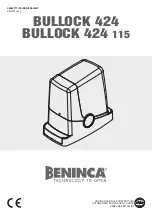
9
GB
3.6) Checking the connections
The following operations entail working on live circuits;
most of these run on extra-low safety voltage so they are
not dangerous; however, some are mains voltage circuits,
which means they are HIGHLY DANGEROUS! Pay the
utmost attention to what you are doing and NEVER WORK
ALONE!
• Power the control unit and check that voltage between terminals
17-18 is approx. 24Vac.
• Check that the “OK” LED flashes rapidly for a few moments and
then that it flashes at a regular frequency.
• Now check that the LED’s related to the N.C. (Normally Closed)
contacts are on (all safety devices active) and that the LED’s relat-
ed to the N.O. (Normally Open) inputs are off (no command); if this
is not the case, check the connections and efficiency of the vari-
ous devices. The STOP input switches off both FCA and FCC.
• Release the leaves, take them to the halfway point and then stop
them; this way the leaves will be free to move in either the open-
ing or closing direction.
• Now make sure that movement occurs in the right direction, i.e.,
see whether the movement set on the unit corresponds to that of
the leaves. This check is of paramount importance, if the direction
is wrong, in some cases (in the “Semiautomatic” mode, for
instance) the “Automatic” system might appear to be working
properly; in fact, the OPEN cycle is similar to the CLOSE cycle but
with one basic difference: the safety devices are ignored in the
closing manoeuvre, which is normally the most dangerous, and
they will trigger in the opening manoeuvre, causing the gate to
close against an obstacle with disastrous results!
• To see whether the direction of rotation is correct, give a short
impulse to the Open input and make sure that the automatic sys-
tem moves in the opening direction; if this movement is incorrect,
proceed as follows:
– Turn the power off
– Invert the power conductors of the wrong motor/s. (In the case
of M1, invert the connection of terminals 8-10; for M2, invert the
connection of terminals 11 – 13).
– Once this has been done, check whether the direction of rota-
tion is correct by repeating the last operation.
The “OK” LED located in the centre of the board next to the micro-
processor has the task of signalling the status of the internal logic:
regular flashing at 1 second intervals indicates that the internal
microprocessor is active and waiting for commands. When the
microprocessor recognises a variation in the status of an input
(whether it is a command or a function Dip-Switch input) it generates
a rapid double flash even if the variation does not have any immedi-
ate effects. Extremely rapid flashing for 3 seconds means that the
control unit has just been powered or is carrying out internal testing.
Lastly, irregular flashing means that the test has been unsuccessful
and that a fault has occurred.
!
Содержание BM4000
Страница 12: ...2009_067_MG_08 04 2011 www niceforyou com Nice SpA Oderzo TV Italia info niceforyou com...
Страница 31: ...6 5 5a 5b 5c 5d 7 L A B RX RX...
Страница 42: ...7 EN 4 a b 5...
















































